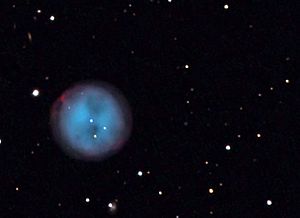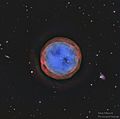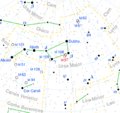Owl nebula facts for kids
The Owl Nebula is a beautiful cloud of gas and dust far out in space. It's called a planetary nebula, but don't let the name fool you! It has nothing to do with planets. This type of nebula forms when a star like our Sun reaches the end of its life. It's located in the constellation of Ursa Major, which you might know as the Big Dipper. The Owl Nebula is super far away, about 2,300 light-years from Earth. A light-year is the distance light travels in one year, which is a very, very long way!
Contents
What is a Planetary Nebula?
A planetary nebula is a special kind of cloud in space. It's made of gas and plasma. These clouds form when a star, similar to our Sun, runs out of fuel. The star then expands into a red giant. After this, it sheds its outer layers into space. This creates a glowing shell of gas around the star's core. The hot core that is left behind is called a white dwarf. This white dwarf makes the gas glow brightly.
Why is it called the Owl Nebula?
The Owl Nebula gets its name because of its shape. When you look at it through a telescope, it looks a bit like an owl's face. It has two dark, round areas that look like the eyes of an owl. These "eyes" are actually less dense areas within the gas cloud.
Where is the Owl Nebula located?
The Owl Nebula is found in the northern sky. It is part of the Ursa Major constellation. This constellation is famous for its bright stars that form the Big Dipper shape. You can find the Owl Nebula near the "bowl" part of the Big Dipper.
Discovery and Observation
The Owl Nebula was first discovered a long time ago. A French astronomer named Pierre Méchain found it in 1781. Later that year, another famous astronomer, Charles Messier, added it to his list of celestial objects. This is why it's also known as Messier 97, or M97.
How big is the Owl Nebula?
The Owl Nebula is quite large in space. It stretches out about 3 light-years across. This means it would take light three years to travel from one side of the nebula to the other. Even though it's big, it's very faint. You usually need a good telescope to see it clearly.
Images for kids
See also
 In Spanish: Nebulosa del Búho para niños
In Spanish: Nebulosa del Búho para niños





